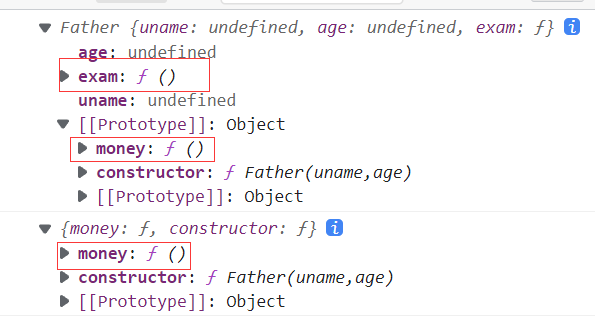利用原型对象继承方法
首先清楚constructor属性所有的对象都可以访问constructor属性,该属性返回对象构造函数,返回值是对函数的引用,而不是函数的名称。
1.借用父构造函数继承属性,使用call()方法,改变this的指向。代码验证
<script>
// 1.借用父构造函数继承属性
function Father(uname,age) {
// this指向父构造函数的实例对象
this.uname = uname;
this.age = age;
}
// 2.子构造函数
function Son(uname1,age1) {
// 子构造函数想要继承父亲的属性
// 这里的this指向的是子构造函数函数,因为call方法修改了this的指向
// uname1和age1是实参,传到Father这个构造函数里面
Father.call(this,uname1,age1);
}
var son = new Son('郭富城',18);
//输出结果相当于是使用了Father这个构造函数,参数名称是uname和age,而不是uname1和age1
console.log(son);
</script>
代码验证
<script>
// 1.借用父构造函数继承属性
function Father(uname,age) {
// this指向父构造函数的实例对象
this.uname = uname;
this.age = age;
}
// 2.子构造函数
function Son(uname1,age1,score) {
// 子构造函数想要继承父亲的属性
// 这里的this指向的是子构造函数函数,因为call方法修改了this的指向
// uname和age是实参,传到Father这个构造函数里面
Father.call(this,uname1,age1);
this.score = score;
}
// 给父原型对象添加方法
Father.prototype.money = function(){
console.log('爸爸赚钱100');
}
// 这样直接赋值确实可以得到父原型对象的值,但是如果修改了子原型对象,父原型对象也会被修改
// Son.prototype = Father.prototype;
// new Father()实例化了对象,赋值给了子原型对象,原来的子原型对象就没有了
// 需要用constructor指回原来的构造函数
Son.prototype = new Father();
Son.prototype.constructor = Son;
// 子构造函数专门的方法
Son.prototype.exam = function(){
console.log('孩子要考试');
}
var son = new Son('郭富城',18);
console.log(Son.prototype);
console.log(Father.prototype);
</script>

这个真的好绕啊!!!!过几天再看一遍



 浙公网安备 33010602011771号
浙公网安备 33010602011771号